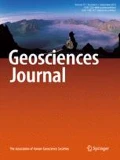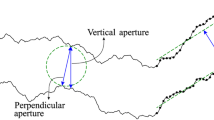Abstract
In present engineering applications, calculations of hydraulic properties in two-phase flow are still highly dependent on empirical or semi-empirical equations obtained from experiments. However, the empirical equations that can reproduce the experiment data on a certain fracture specimen may have errors on other specimens. Researchers have obtained results that show quite different evolution forms of hydraulic characteristics of two-phase flow, which is induced by the variety of the influencing factors in two-phase flow. This paper aims at expanding the experimental results on the hydraulic characteristics of two-phase flow in rock fractures. With a newly developed experiment system, visualized two-phase flow experiments were introduced. The difference in the surface morphology of the fractures leads to totally different flow structures, which indicates the role of capillary pressure differs due to different fracture surfaces. The relative permeability in the rough specimen approximately follows the Corey model, which confirmed that the pressure drop is in this rough fracture is dominated by the capillary pressure, but the relative permeability is not only the function of saturation, but also the function of water flow velocities. However, the relative permeability is not perfect for evaluating the difference of two-phase hydraulic characteristics induced by the fracture surface morphology. On the contrary, the Lockhart-Martinelli model is appropriate for evaluating the difference in the two-phase hydraulic characteristics between the smooth fracture and the rough fracture, which indicates that the two-phase flow turbulence is obviously increased by the fracture roughness.
Similar content being viewed by others
References
Bachu, S. and Bennion, B., 2008, Effects of in-situ conditions on relative permeability characteristics of CO2-brine systems. Environmental Geology, 54, 1707–1722.
Brooks, R. and Corey, A., 1964, Hydraulic properties of porous media. Hydrology Paper No.3, Colorado State University, Fort Collins, 37 p.
Chen, C.Y., 2005, Liquid-gas relative permeabilities in fractures: effects of flow structures, phase transformation and surface roughness. Ph.D. Thesis, Stanford University, Stanford, 201 p.
Corey, A.T., 1954, The interrelation between gas and oil relative permeabilities. Producers Monthly, 19, 38–41.
Dana, E. and Skoczylas, F., 1999, Gas relative permeability and pore structure of sandstones. International Journal of Rock Mechanics and Mining Science, 36, 613–625.
Delhaye, J.M., Giot, M., and Riethmuller, M.L., 1981, Thermohydraulics of Two-phase Systems for Industrial Design and Nuclear Engineering. Hemisphere Publishing Corporation, Washington D.C., 525 p.
Detwiler, R.L., Rajaram, H., and Glass, R.J., 2009, Interphase mass transfer in variable aperture fractures: controlling parameters and proposed constitutive relationships. Water Resources Research, 45, W08436.
Diomampo, G.P., 1993, Viscous coupling in two-phase flow in porous media and its effect on relative permeabilities. Transport in Porous Media, 11, 201–218.
Diomampo, G.P., 2001, Relative permeability through fractures. Master Thesis, Stanford University, Stanford, 201 p.
Feng, W., 2009, Coalbed methane reservoir engineering. Science Press, Beijing, 270 p. (in Chinese)
Fourar, M. and Bories, S., 1993, Two-phase flow in smooth and rough fractures: measurement and correlation by porous-medium and conduit flow models. Water Resources Research, 29, 3699–3708.
Fourar, M. and Bories, S., 1995, Experimental study of air-water two-phase flow through a fracture (narrow channel). International Journal of Multiphase Flow, 21, 621–637.
Fourar, M. and Lenormand, R., 1998, A viscous coupling model for relative permeabilities in a fracture. SPE Annual Technical Conference and Exhibition, New Orleans, Sep. 27–30. https://doi.org/10.2118/49006-MS
Fourar, M. and Lenormand, R., 2000, Inertial effects in two-phase flow through fractures. Oil and Gas Science and Technology, 55, 259–268.
Gilman, J.R. and Kazemi, H., 1983, Improvements in simulation of naturally fractured reservoirs. Society of Petroleum Engineers Journal, 23, 695–707.
Kimura, S., 1997, Geothermal energy development and multiphase flows. Japanese Journal of Multiphase Flow, 11, 11–14.
Nuske, P., Faigle, B., Helmig, R., Niessner, J., and Neuweiler, I., 2010, Modeling gas-water processes in fractures with fracture flow properties obtained through upscaling. Water Resources Research, 46, 201–210.
Persoff, P. and Pruess, K., 1995, Two-phase flow visualization and relative permeability measurement in natural rough-walled rock fractures. Water Resources Research, 31, 1175–1186.
Pruess, K. and Tsang, Y.W., 1990, On two-phase relative permeability and capillary pressure of rough-walled rock fractures. Water Resources Research, 26, 1915–1926.
Romm, E.S., 1966, Fluid Flow in Fractured Rocks. Nedra Publishing House, Moscow, 283 p. (in Russian) (Translated by Blake, W.R., 1972, Bartlesville)
Sudicky, E.A. and Frind, E.O., 1982, Contaminant transport in fractured porous media: analytical solutions for a system of paralleled fractures. Water Resources Research, 18, 1634–1642.
Thomas, L.K., Dixon, T.N., and Pierson, R.G., 1983, Fractured reservoir simulation. Society of Petroleum Engineers Journal, 23, 42–54.
Watanabe, N., Sakurai, K., Ishibashi, T., Ohsaki Y., Tamagawa, T., Yagi, M., and Tsuchiya, N., 2014, New v-type relative permeability curves for two-phase flows through subsurface fractures. Water Resources Research, 51, 2807–2824.
Whitaker, S., 1986, Flow in porous media II: the governing equations for immiscible, two-phase flow. Transport in Porous Media, 105–125.
Acknowledgments
This study was partially funded by JSPS-NSFC Bilateral Joint Research Project (Grant No. 51611140122), Japan. The supports are gratefully acknowledged.
Author information
Authors and Affiliations
Corresponding author
Additional information
Publisher’s Note
Springer Nature remains neutral with regard to jurisdictional claims in published maps and institutional affiliations.
Rights and permissions
About this article
Cite this article
Wang, C., Jiang, Y., Liu, J. et al. Visualized experimental investigation on the hydraulic characteristics of two-phase flow in a single smooth and single rough rock fractures. Geosci J 25, 351–361 (2021). https://doi.org/10.1007/s12303-020-0029-4
Received:
Accepted:
Published:
Issue Date:
DOI: https://doi.org/10.1007/s12303-020-0029-4




